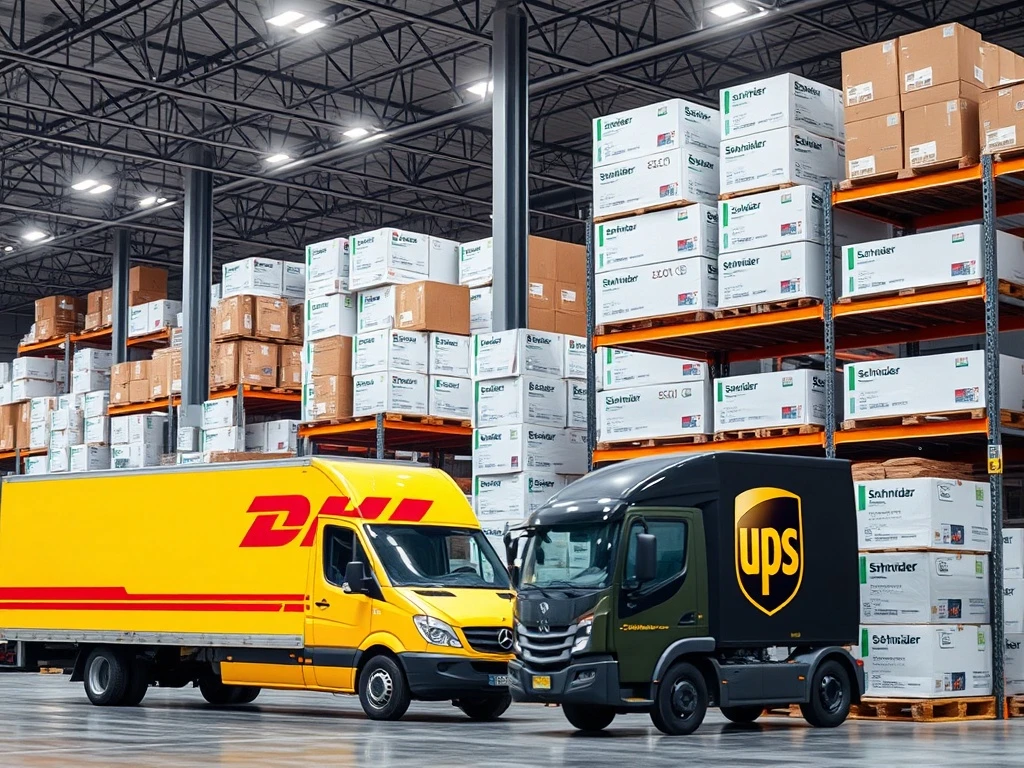For industrial procurement specialists, managing shipping costs for essential Schneider PLC shipping equipment presents a constant challenge. Today’s volatile logistics market significantly impacts budgets. Automation components are crucial for maintaining production efficiency. Therefore, rising shipping expenses can greatly affect procurement budgets and overall project costs. Strategic shipping optimization through DHL and UPS services offers substantial opportunities for cost reduction. This guide explores practical solutions to minimize shipping expenses. It also ensures reliable delivery of Schneider PLC components. We examine proven strategies that procurement professionals can implement immediately. These methods achieve measurable savings without compromising service quality or delivery timelines.
Understanding Schneider PLC Shipping Fundamentals
When shipping Schneider PLC components, procurement specialists must understand several critical factors. These factors influence shipping costs and delivery reliability. Both DHL and UPS calculate rates primarily based on dimensional weight. This considers both physical weight and package volume. For Schneider PLCs, sensitive electronic components often require special handling. This can incur additional fees. Understanding Incoterms is crucial for managing these costs. FOB (Free On Board) and CIF (Cost, Insurance, Freight) terms significantly impact final costs. They also determine responsibility allocation.
Furthermore, regular orders typically see better rates than sporadic purchases. Consolidated shipments can substantially reduce per-unit costs. Essential documentation includes commercial invoices, packing lists, and certificates of origin for international shipments. Watch for hidden charges. These include residential delivery fees, signature requirements, and peak season surcharges. Remote location surcharges and special handling for electronic components can add unexpected costs. Procurement specialists should also verify insurance coverage limits. Additionally, they must check customs documentation requirements, especially for cross-border shipments of industrial automation equipment.
DHL vs. UPS: Optimizing Schneider PLC Shipping Routes
Comparing DHL Express and UPS Express Saver for Schneider PLC shipments reveals key differentiators. These differences impact total shipping costs. DHL Express generally offers faster transit times for international routes. It averages 1-2 days faster than UPS Express Saver on major industrial corridors. However, UPS demonstrates stronger domestic coverage. It often provides more competitive rates for heavy industrial components within national borders. Specifically for Schneider PLC shipments, DHL’s specialized electronic handling procedures and temperature-controlled options command a 5-15% premium. Nevertheless, they deliver superior protection for sensitive automation equipment. UPS counters with more flexible pickup windows. It also offers better integration with customs clearance systems in North America.
Analysis of major shipping routes reveals distinct cost patterns. For North American shipments between major industrial hubs, UPS Express Saver averages 12% lower costs. This applies to standard PLC units, particularly for ground routes under 1000 miles. European corridors show DHL’s strength. They offer 15-20% faster clearance times and more predictable delivery windows for automation equipment. Emergency shipments during production downtimes typically incur 2-3x standard rates. However, DHL’s time-definite services often justify the premium. They guarantee specific delivery windows. Bulk shipments of 10+ units demonstrate the most dramatic cost variations. UPS offers deeper volume discounts starting at 25% for regular customers. Conversely, DHL’s advantage lies in multi-point distribution efficiency for international consignments.
Maximizing Savings: Bulk Strategies for Schneider PLC Shipping
Strategic bulk ordering presents significant opportunities for reducing Schneider PLC shipping costs. This applies to both DHL and UPS channels. Volume discounts typically activate at 10-unit thresholds. Progressive savings can reach up to 40% for orders exceeding 25 units. Consolidating shipments across multiple sites into single-origin deliveries can yield additional reductions. Expect 15-20% reductions in per-unit shipping costs. Seasonal patterns show optimal ordering windows during Q4 and Q1. During these times, carriers offer enhanced bulk rates to maintain market share.
When negotiating carrier contracts, focus on securing several key benefits:
- Multi-year rate locks
- Dimensional weight waivers for regular shipments
- Fuel surcharge caps
Payment terms optimization through early settlement discounts can provide an extra 2-3% savings on total logistics costs. For maximum effectiveness, utilize shipping weight breakpoints. Orders just under weight category thresholds often cost the same as maxing out that weight band. Key variables for bulk order optimization include unit dimensions. Standard Schneider PLC modules average 0.5 cubic feet. Consider destination zones and carrier-specific volume tiers. Also, consider duty optimization. Strategically split international bulk orders to stay under duty-free thresholds. This maintains volume discount benefits. Advanced procurement specialists can leverage cross-docking opportunities at major hubs. This combines orders from multiple suppliers. It achieves higher volume discounts while maintaining individual delivery schedules.
Securing Free Delivery on Schneider PLC Orders
Strategic procurement specialists can effectively eliminate shipping costs on Schneider PLC shipping orders. Several proven methods exist. Most distributors offer free shipping for orders exceeding $5,000. This makes consolidating smaller purchases highly advantageous. Seasonal promotions, typically occurring during Q4 and Q2, frequently waive shipping fees. This happens regardless of order value. Loyalty program participation unlocks year-round free shipping benefits. Platinum-tier members, for example, enjoy unlimited free delivery on all orders.
However, geographic restrictions often apply. Free shipping usually covers major metropolitan areas and industrial zones. Remote locations may still incur base charges. Hybrid carrier solutions, combining local freight consolidators with major carriers, can eliminate costs. This applies even for traditionally restricted zones. To maximize free shipping opportunities, procurement specialists should maintain relationships with multiple authorized distributors. Their promotional calendars often complement each other. Additionally, participating in vendor-managed inventory programs often includes shipping cost absorption. This is a standard benefit. For time-critical orders that do not meet free shipping thresholds, consider consolidation. Combine orders with regular maintenance supplies. Or, combine orders across departments. This helps reach qualification levels without compromising delivery timelines.
Step-by-Step Optimization for Schneider PLC Shipping
Implementing an efficient shipping process for Schneider PLC components requires a systematic approach. First, verify product specifications and destination details. This includes special handling requirements and customs regulations for international shipments. Next, utilize a carrier selection framework. This framework weighs transit times against costs. Choose DHL for time-critical international shipments. Select UPS for domestic routes with standard delivery windows. When activating bulk discounts, consolidate orders across departments. This meets minimum thresholds. Then, negotiate volume-based rates with preferred carriers.
Furthermore, streamline documentation processes. Use automated shipping platforms that integrate with procurement systems. This ensures accurate commercial invoices and packing lists. Finally, implement regular shipping audits. Identify overcharges, track carrier performance, and recover refunds for service failures. This systematic approach consistently yields 15-25% cost reductions. It also maintains delivery reliability.
Achieving Substantial Savings in Schneider PLC Shipping
By strategically approaching Schneider PLC shipping through DHL and UPS, procurement specialists can achieve substantial cost reductions. They also maintain service quality. Leveraging carrier-specific advantages provides a strong foundation. DHL offers international expertise. UPS boasts a strong domestic network. This combination supports optimized shipping decisions. Bulk ordering strategies, when properly executed, consistently deliver 25-40% savings. These strategies involve volume thresholds and consolidation techniques. Free shipping opportunities further enhance cost control. This comes through strategic order timing and loyalty program participation. The key to sustained success lies in continuous monitoring and adaptation of shipping strategies. Carrier policies and market conditions evolve. Take immediate action by implementing the volume consolidation approach. This offers the quickest path to measurable savings. As global logistics advances, procurement specialists mastering these techniques will drive increasing value. They also ensure reliable delivery of critical automation components.
Frequently Asked Questions (FAQs) About Schneider PLC Shipping
Q1: What is dimensional weight, and how does it affect Schneider PLC shipping costs?
A1: Dimensional weight is a pricing technique that considers a package’s volume (length x width x height) in addition to its actual weight. Carriers use the greater of the two to calculate shipping costs. For Schneider PLCs, which can be bulky, understanding and optimizing packaging to reduce dimensional weight can significantly lower expenses.
Q2: How can I secure free shipping for my Schneider PLC orders?
A2: Many distributors offer free shipping for orders above a certain value (e.g., $5,000). Consolidating smaller orders, participating in loyalty programs, and taking advantage of seasonal promotions (often Q4 and Q2) are effective strategies. Some vendor-managed inventory programs also include shipping cost absorption.
Q3: When should I choose DHL versus UPS for Schneider PLC shipments?
A3: Choose DHL for time-critical international shipments, as they often offer faster transit times and specialized electronic handling. For domestic routes, especially within North America, UPS often provides more competitive rates and stronger ground network coverage for standard delivery windows.
Q4: What are the benefits of bulk ordering for Schneider PLC shipping?
A4: Bulk ordering activates volume discounts, potentially saving 25-40% on per-unit shipping costs. Consolidating shipments from multiple sites into single deliveries also reduces overall expenses. Negotiating multi-year rate locks and dimensional weight waivers with carriers further maximizes these savings.
Q5: What documentation is essential for international Schneider PLC shipments?
A5: Essential documentation includes a commercial invoice, packing list, and certificate of origin. For electronic components like Schneider PLCs, you may also need specific customs declarations or import licenses depending on the destination country’s regulations. Always verify Incoterms (FOB, CIF) to clarify responsibilities.
























